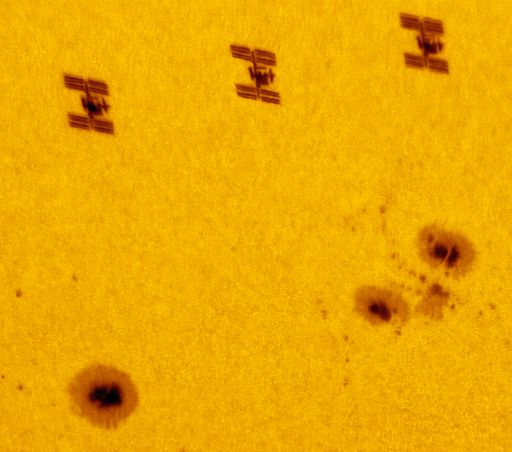When is the best time to see auroras? Where is the best place to go? And how do you photograph them? These questions and more are answered in a new book, Northern Lights - a Guide, by Pal Brekke & Fredrik Broms. | | | WAITING FOR FLARES: For days, solar activity has been low, but the quiet seems unlikely to last. Two big sunspots, AR2108 and AR2109, have unstable "beta-gamma-delta" magnetic fields that harbor energy for strong, Earth-directed eruptions. NOAA forecasters estimate a 60% chance of M-flares and a 10% chance of X-flares on July 7th. Solar flare alerts: text, voice BRIGHT NOTILUCENT CLOUDS: Last night, another bright display of noctilucent clouds lit up the skies over Europe. The luminous ripples were so bright, "they actually lit up my room a blue colour," reports UK photographer Mark Savage. Click on this photo to set the clouds in motion over his hometown, Gateshead, England: 
"This was the best display of noctilucent clouds I've seen for a number of years," he says. Similar reports have been received from Poland, Scotland, Russia and other parts of Europe. July is the best month of the year for noctilucent clouds in the northern hemisphere. So far, the vast majority of sightings have been in Europe. It is only a matter of time however, before the electric-blue ripples spread to North America. Observing tips: Look west 30 to 60 minutes after sunset when the Sun has dipped 6o to 16o below the horizon. If you see luminous blue-white tendrils spreading across the sky, you may have spotted a noctilucent cloud. Realtime NLC Photo Gallery SPACE STATION TRANSITS THE SUN: As wide as a World Cup football field, the biggest spacecraft ever built makes a impressive silhouette when it passes in front of the sun. On July 5th, Maximilian Teodorescu of Romania caught the winged shadow of the International Space Station in conjuncton with sunspots AR2104 and AR2107: 
"This is my first attempt to catch the station with a small-sensor camera at high magnification," he says. "I managed to catch the ISS in three frames." His wife Eliza was right beside him with her own camera and solar filter, and she caught it too. "The moment was all the more spectacular because the ISS path was almost parallel to the very numerous string of sunspots," she notes. One conjunction after another unfolded as their cameras rolled. With the sunspot number so high, now is a good time to catch ISS-sunspot conjunctions. Check Calsky for local transit predictions. Realtime Space Weather Photo Gallery
Realtime Comet Photo Gallery
Realtime Aurora Photo Gallery
Every night, a network of NASA all-sky cameras scans the skies above the United States for meteoritic fireballs. Automated software maintained by NASA's Meteoroid Environment Office calculates their orbits, velocity, penetration depth in Earth's atmosphere and many other characteristics. Daily results are presented here on Spaceweather.com. On Jul. 7, 2014, the network reported 10 fireballs.
( 10 sporadics)  In this diagram of the inner solar system, all of the fireball orbits intersect at a single point--Earth. The orbits are color-coded by velocity, from slow (red) to fast (blue). [Larger image] [movies] Potentially Hazardous Asteroids ( PHAs) are space rocks larger than approximately 100m that can come closer to Earth than 0.05 AU. None of the known PHAs is on a collision course with our planet, although astronomers are finding new ones all the time. On July 7, 2014 there were 1489 potentially hazardous asteroids. Notes: LD means "Lunar Distance." 1 LD = 384,401 km, the distance between Earth and the Moon. 1 LD also equals 0.00256 AU. MAG is the visual magnitude of the asteroid on the date of closest approach. | | The official U.S. government space weather bureau | | | The first place to look for information about sundogs, pillars, rainbows and related phenomena. | | | Researchers call it a "Hubble for the sun." SDO is the most advanced solar observatory ever. | | | 3D views of the sun from NASA's Solar and Terrestrial Relations Observatory | | | Realtime and archival images of the Sun from SOHO. | | | from the NOAA Space Environment Center | | | the underlying science of space weather | | 
